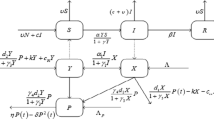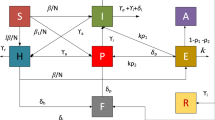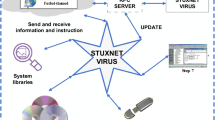Abstract
In this study, the numerical investigations through the stochastic procedures for solving a class of fractional order (FO) computer virus propagation (CVP) mathematical model with kill signals (KS), i.e., CVP-KS is presented. The KS gets alert about those viruses, which can be infected through the computer system to decrease the virus propagation danger. The mathematical model of the CVP-KS is based on the SEIR-KS model. The focus of these investigations is to present the numerical solutions of the FO-SEIR-KS model using the sense of Levenberg–Marquardt backpropagation scheme (LMBS) together with the neural networks (NNs), i.e., LMBS-NNs. The use of the one dynamic of the other makes the model nonlinear. Three different FO values have been used to check the performances of the designed scheme for this FO-SEIR-KS nonlinear mathematical model. The statics used in this study is 80%, 10% and 10% for training, testing and certification for solving the FO-SEIR-KS nonlinear mathematical model. The numerical simulations are performed through the stochastic LMBS-NNs scheme for solving the FO-SEIR-KS nonlinear mathematical model. The obtained results will be compared with the design of database reference solutions based on the Adams–Bashforth–Moulton. In order to accomplish the validity, capability, consistency, competence and accuracy of the LMBS-NNs, the numerical results using the error histograms, regression, mean square error, state transitions and correlation have been provided.








Similar content being viewed by others
References
Han X, Tan Q (2010) Dynamical behavior of computer virus on Internet. Appl Math Comput 217:2520–2526
Piqueira JRC, Araujo VO (2009) A modified epidemiological model for computer viruses. Appl Math Comput 213:355–360
Kim J, Radhakrishana S, Jang J (2006) Cost optimization in SISmodel of worm infection. ETRI J 28:692–695
Yang LX, Yang X (2012) The spread of computer viruses under the influence of removable storage devices. Appl Math Comput 219:3914–3922
Yang LX, Yang X, Wen L, Liu J (2012) A novel computer virus propagation model and its dynamics. Int J Comput Math 89:2307–2314
Billings L, Spears WM, Schwartz IB (2002) A unified prediction of computer virus spread in connected networks. Phys Lett A 297:261–266
Mishra BK, Pandey SK (2011) Dynamic model of worms with vertical transmission in computer network. Appl Math Comput 217:8438–8446
Gan C, Yang X, Liu W, Zhu Q (2014) A propagation model of computer virus with nonlinear vaccination probability. Commun Nonlinear Sci Numer Simul 19:92–100
Gan C, Yang X, Zhu Q, Jin J, He L (2013) The spread of computer virus under the effect of external computers. Nonlinear Dyn 73:1615–1620
Muroya Y, Enatsu Y, Li H (2013) Global stability of a delayed SIRS computer virus propagation model. Int J Comput Math 91:347–367
Feng L, Liao X, Li H, Han Q (2012) Hopf bifurcation analysis of a delayed viral infection model in computer networks. Math Comput Modell 56:167–179
Zhu Q, Yang X, Yang LX, Zhang C (2012) Optimal control of computer virus under a delayed model. Appl Math Comput 218:11613–11619
Ren J, Yang X, Yang L-X, Xu Y, Yang F (2012) A delayed computer virus propagation model and its dynamics. Chaos Solitons Fractals 45:74–79
Zhu QY, Yang XF, Yang LX (2013) A mixing propagation model of computer viruses and countermeasures. Nonlinear Dyn 73:1433–1441
Yang LX, Yang XF (2014) The pulse treatment of computer viruses: a modeling study. Nonlinear Dyn 76:1379–1393
Yang LX, Draief M, Yang XF (2016) The optimal dynamics immunization under a controlled heterogeneous node-based SIRS model. Physica A 450:403–415
Mishra BK, Jha N (2007) Fix period of temporary immunity after run of anti-malicious software on computer nodes. Appl Math Comput 190:1207–1212
Kephart JO, White SR (1993) Measure and modeling computer virus prevalence. In: IEEE computer society symposium research in security and privacy
Changpin L, Yujiang W, Ruisong Y (2013) Recent advances in applied nonlinear dynamics with numerical analysis. World Scientific, Singapore
Baleanu D, Diethelm K, Scalas E, Trujill JJ (2012) Models and numerical methods. World Scientific, Singapore
Gorenflo R, Mainardi F (1997) Fractals and fractional calculus in continuum mechanics. Springer, New York, pp 223–276
Dabiri A, Moghaddam BP, Machado JAT (2018) Optimal variable-order fractional PID controllers for dynamical systems. J Comput Appl Math 339:40–48
Evirgen F, Özdemir N (2012) A fractional order dynamical trajectory approach for optimization problem with HPM. In: Fractional dynamics and control. Springer, New York, NY, pp 145–155
Koca I, Ozalp N (2013) Analysis of a fractional-order couple model with acceleration in feelings. Sci World J 2013:730736
Li P, Chen L, Wu R, Machado JAT, Lopes AM, Yuan L (2018) Robust asymptotic stability of interval fractional-order nonlinear systems with time-delay. J Frankl Inst 355:7749–7763
Rossikhin YA, Shitikova MV (1997) Applications of fractional calculus to dynamic problems of linear and nonlinear hereditary mechanics of solids. Appl Mech Rev 50(1):15–67
Marks RJII, Hall M (1981) Differintegral interpolation from a bandlimited signal’s samples. IEEE Trans Acoust Speech Signal Process 29(4):872–877
Cole KS (1933) Electric conductance of biological systems. In: Cold Spring Harbor symposia on quantitative biology, vol 1. Cold Spring Harbor Laboratory Press, pp 107–116
Jajarmi A, Baleanu D, Sajjadi SS, Asad JH (2019) A new feature of the fractional Euler–Lagrange equations for a coupled oscillator using a nonsingular operator approach. Front Phys 7:196
Kumar D, Singh J, Baleanu D (2020) On the analysis of vibration equation involving a fractional derivative with Mittag–Leffler law. Math Methods Appl Sci 43(1):443–457
Singh J, Kumar D, Baleanu D, Rathore S (2019) On the local fractional wave equation in fractal strings. Math Methods Appl Sci 42(5):1588–1595
Bhatter S, Mathur A, Kumar D, Singh J (2020) A new analysis of fractional Drinfeld–Sokolov–Wilson model with exponential memory. Physica A 537:122578
Bhatter S, Mathur A, Kumar D, Nisar KS, Singh J (2020) Fractional modified Kawahara equation with Mittag–Leffler law. Chaos, Solitons Fractals 131:109508
Boukhouima A, Hattaf K, Yousfi N (2017) Dynamics of a fractional order HIV infection model with specific functional response and cure rate. Int J Differ Equ 2017:8372140
Singh J (2020) Analysis of fractional blood alcohol model with composite fractional derivative. Chaos, Solitons Fractals 140:110127
Singh J, Kumar D, Baleanu D (2021) New aspects of fractional Bloch model associated with composite fractional derivative. Math Model Natl Phenomena 16:10–26
Singh J, Kumar D, Hammouch Z, Atangana A (2018) A fractional epidemiological model for computer viruses pertaining to a new fractional derivative. Appl Math Comput 316:504–515
Singh J, Gupta A, Baleanu D (2022) On the analysis of an analytical approach for fractional Caudrey–Dodd–Gibbon equations. Alex Eng J 61(7):5073–5082
Baleanu D, Jajarmi A, Mohammadi H, Rezapour S (2020) A new study on the mathematical modelling of human liver with Caputo–Fabrizio fractional derivative. Chaos Solitons Fractals 134:109705
Jajarmi A, Arshad S, Baleanu D (2019) A new fractional modelling and control strategy for the outbreak of dengue fever. Physica A 535:122524
Ghanbari B et al (2020) Mathematical and numerical analysis of a three-species predator-prey model with herd behavior and time fractional-order derivative. Math Methods Appl Sci 43(4):1736–1752
Ren J, Xu Y (2017) A compartmental model for computer virus propagation with kill signals. Physica A 486:446–454
Özdemir N, Uçar S, Eroğlu BBİ (2020) Dynamical analysis of fractional order model for computer virus propagation with kill signals. Int J Nonlinear Sci Numer Simul 21(3–4):239–247
Nisar K et al (2021) Design of morlet wavelet neural network for solving a class of singular pantograph nonlinear differential models. IEEE Access 9:77845–77862
Nisar K et al (2021) Evolutionary integrated heuristic with Gudermannian neural networks for second kind of Lane–Emden nonlinear singular models. Appl Sci 11:4725. https://doi.org/10.3390/app11114725
Shoaib M et al (2021) Intelligent computing with Levenberg–Marquardt backpropagation neural networks for third-grade nanofluid over a stretched sheet with convective conditions. Arab J Sci Eng 43:1–19
Sabir Z, Raja MAZ, Alnahdi AS, Jeelani MB, Abdelkawy MA (2022) Numerical investigations of the nonlinear smoke model using the Gudermannian neural networks. Math Biosci Eng 19(1):351–370
Naz S, Raja MAZ, Kausar A, Zameer A, Mehmood A, Shoaib M (2022) Dynamics of nonlinear cantilever piezoelectric–mechanical system: an intelligent computational approach. Math Comput Simul 196:88–113
Kiani AK et al (2021) Intelligent backpropagation networks with bayesian regularization for mathematical models of environmental economic systems. Sustainability 13(17):9537
Anwar N et al (2022) Artificial intelligence knacks-based stochastic paradigm to study the dynamics of plant virus propagation model with impact of seasonality and delays. Eur Phys J Plus 137(1):1–47
Sabir Z, Umar M, Raja MAZ, Baskonus HM, Gao W (2021) Designing of Morlet wavelet as a neural network for a novel prevention category in the HIV system. Int J Biomath 15:2250012
Sabir Z, Raja MAZ, Baleanu D, Cengiz K, Shoaib M (2021) Design of Gudermannian Neuroswarming to solve the singular Emden–Fowler nonlinear model numerically. Nonlinear Dyn 106:1–16
Sabir Z, Raja MAZ, Guirao JL, Saeed T (2021) Meyer wavelet neural networks to solve a novel design of fractional order pantograph Lane–Emden differential model. Chaos Solitons Fractals 152:111404
Sabir Z, Raja MAZ, Umar M, Shoaib M, Baleanu D (2021) FMNSICS: fractional meyer neuro-swarm intelligent computing solver for nonlinear fractional Lane–Emden systems. Neural Comput Appl 34:1–14
Naz S et al (2021) Weighted differential evolution heuristics for improved multilayer piezoelectric transducer design. Appl Soft Comput 113:107835
Ilhan E et al (2020) A generalization of truncated M-fractional derivative and applications to fractional differential equations. Appl Math Nonlinear Sci 5(1):171–188
Sabir Z, Raja MAZ, Guirao JL, Saeed T (2021) Solution of novel multi-fractional multi-singular Lane–Emden model using the designed FMNEICS. Neural Comput Appl 33(24):17287–17302
Baskonus HM et al (2019) New complex hyperbolic structures to the lonngren-wave equation by using sine-gordon expansion method. Appl Math Nonlinear Sci 4(1):141–150
Sabir Z, Nisar K, Raja MAZ, Ibrahim AABA, Rodrigues JJ, Al-Basyouni KS, Mahmoud SR, Rawat DB (2021) Design of Morlet wavelet neural network for solving the higher order singular nonlinear differential equations. Alex Eng J 60(6):5935–5947
Sabir Z, Akhtar R, Zhiyu Z, Umar M, Imran A, Wahab HA, Shoaib M, Raja MAZ (2019) A computational analysis of two-phase casson nanofluid passing a stretching sheet using chemical reactions and gyrotactic microorganisms. Math Prob Eng 2019:1490571
Sajid T et al (2021) Impact of oxytactic microorganisms and variable species diffusivity on blood-gold Reiner-Philippoff nanofluid. Appl Nanosci 11(1):321–333
Ayub A, Wahab HA, Sabir Z, Arbi A (2020) A note on heat transport with aspect of magnetic dipole and higher order chemical process for steady micropolar fluid. In: Computational overview of fluid structure interaction, p 97
Ayub A et al (2021) Nanoscale heat and mass transport of magnetized 3-D chemically radiative hybrid nanofluid with orthogonal/inclined magnetic field along rotating sheet. Case Stud Therm Eng 26:101193
Acknowledgements
The first author thanks the Faculty of Sciences and Liberal Arts, Rajamangala University of Technology Isan, Thailand.
Author information
Authors and Affiliations
Corresponding author
Ethics declarations
Conflict of interest
All authors describe that there are no potential conflicts of interest.
Additional information
Publisher's Note
Springer Nature remains neutral with regard to jurisdictional claims in published maps and institutional affiliations.
Rights and permissions
About this article
Cite this article
Sabir, Z., Raja, M.A.Z., Mumtaz, N. et al. An Investigation Through Stochastic Procedures for Solving the Fractional Order Computer Virus Propagation Mathematical Model with Kill Signals. Neural Process Lett 55, 1783–1797 (2023). https://doi.org/10.1007/s11063-022-10963-x
Accepted:
Published:
Issue Date:
DOI: https://doi.org/10.1007/s11063-022-10963-x




